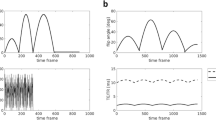Abstract
Direct and repetitive noninvasive determination of the time course and the strain-specific hepatic regenerative capacity after partial hepatectomy can extend our knowledge about the basic mechanisms of liver regeneration and repair. The aim of this study was to develop a magnetic resonance (MR)-based volumetric procedure to measure the hepatic volume in the regenerating mouse liver. In Balb-C mice (n = 14), varying amounts of liver tissue were resected and MR imaging was performed 24 hours later in a 1.5 TeslaMagnet Unit. Three dimensional (3D) T1- (volumetric interpolated breath-hold examination [VIBE] sequence) and T2-weighted images were acquired with continuous 1-mm thin slices. Animals with and without intravenous administration of paramagnetic contrast agents were compared. Immediately after MR examination, mice were euthanized and livers were weighted. The liver volume was determined on MR images using Cavalieri’s method and linear regression analysis was performed from the data obtained. Correlation coefficients between the liver volume measured by MR and the liver weight were 0.98 (T1) and 0.94 (T2) in the group without paramagnetic contrast injection and 0.70 (T1) and 0.96 (T2) after paramagnetic contrast application. We conclude that MR-based liver volumetry allows precise liver volume measurement during hepatic regeneration after partial hepatectomy in mice and can be a valuable tool with regard to experimental hepatology.
Similar content being viewed by others
References
Higgins GM, Anderson RM. Experimental pathology of the liver: Restoration of the liver of the white rat following partial surgical removal. Arch Pathol 1931;12:186–202.
Rahman TM, Hodgson HJ. Animal models of acute hepatic failure. Int J Exp Pathol 2000;81:145–157.
Paulsen JE. Variations in regenerative growth of mouse liver following partial hepatectomy. In Vivo 1990;4:235–238.
Michalopoulos GK, DeFrances MC. Liver regeneration. Science 1997;276:60–66.
Bennett LM, Farnham PJ, Drinkwater NR. Strain-dependent differences in DNA synthesis and gene expression in the regenerating livers of CB57BL/6J and C3H/HeJ mice. Mol Carcinog 1995;14:46–52.
Poltoranina VS, Sorokina TV. [Alpha-fetoprotein synthesis during liver regeneration in adult mice of different strains]. Biull Eksp Biol Med 1978;86:71–75.
Albrecht JH, Poon RY, Ahonen CL, Rieland BM, Deng C, Crary GS. Involvement of p21 and p27 in the regulation of CDK activity and cell cycle progression in the regenerating liver. Oncogene 1998;16:2141–2150.
Patrizio G, Pietroletti R, Pavone P, Foti N, Tettamanti E, Ventura T, Simi M, Passariello R. [An animal model for the study of liver regeneration by magnetic resonance imaging]. Radiol Med (Torino) 1990;79:453–457.
Cockman MD, Hayes DA, Kuzmak BR. Motion suppression improves quantification of rat liver volume in vivo by magnetic resonance imaging. Magn Reson Med 1993;30:355–360.
Pleskovic A, Demsar F, Suput D. Assessment of liver regeneration by quantitative MRI analysis. Pflugers Arch 1996;431:R307-R308.
Hockings PD, Roberts T, Campbell SP, Reid DG, Greenhill RW, Polley SR, Nelson P, Bertram TA, Kramer K. Longitudinal magnetic resonance imaging quantitation of rat liver regeneration after partial hepatectomy. Toxicol Pathol 2002;30:606–610.
Palmes D, Spiegel HU. Animal models of liver regeneration. Biomaterials 2004;25:1601–1611.
Pache JC, Roberts N, Vock P, Zimmermann A, Cruz- Orive LM. Vertical LM sectioning and parallel CT scanning designs for stereology: Application to human lung. J. Microsc 1993;170:9–24.
Van Zutphen LFM, Baumans V, Beynen AC. Principles of Laboratory Animal Science. Amsterdam: Elsevier, 1993.
Author information
Authors and Affiliations
Corresponding author
Rights and permissions
About this article
Cite this article
Inderbitzin, D., Gass, M., Beldi, G. et al. Magnetic resonance imaging provides accurate and precise volume determination of the regenerating mouse liver. J Gastrointest Surg 8, 806–811 (2004). https://doi.org/10.1016/j.gassur.2004.07.013
Issue Date:
DOI: https://doi.org/10.1016/j.gassur.2004.07.013




